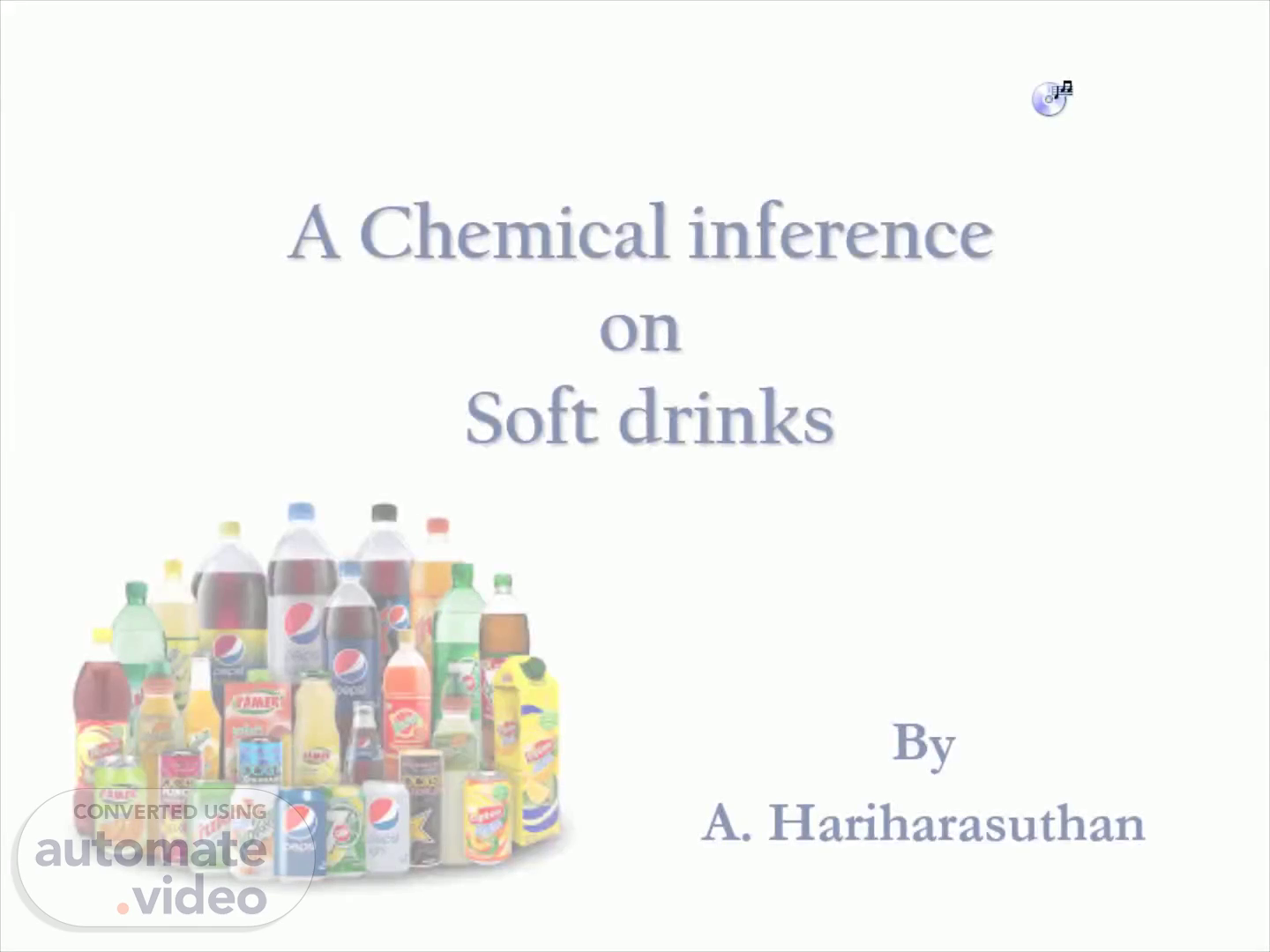
Page 1 (0s)
A Chemical inference on Soft drinks. By A. Hariharasuthan.
Page 2 (10s)
Contents. Introduction Compounds of Soft drink PH value test Carbon dioxide test Glucose test Sucrose test Phosphate test Alcohol test Test for Carbon Dioxide.
Page 3 (20s)
Introduction. A soft drink is a drink that usually contains carbonated water a sweetener, and a natural and/or artificial flavoring. The sweetener may be a sugar, high-fructose corn syrup, fruit juice, a sugar substitute, or some combination of these. The first marketed soft drinks appeared in the 17th century as a mixture of water and lemon juice sweetened with honey. During 18 th century soft drink was introduced to the public as a cure for a variety of illnesses because of the belief that naturally carbonated water contained healing powers. Objective is to discuss the various facts of cool drinks by simple chemical reactions as proof..
Page 4 (48s)
Compounds of Soft drink. Cold drinks of different brands are composed of alcohol, carbohydrates, carbon dioxide, phosphate ions etc. These soft drinks give feeling of warmth, lightness and have a tangy taste which is liked by everyone. Soft drinks are complex mixtures containing variety of substance such as coloring compounds, flavoring agents, acidifiers, sweeteners, preservatives and caffeine ..
Page 5 (1m 12s)
PH value test. Cold drinks are a bit acidic in nature and their acidity can be measured by finding their pH value. Small samples of cool drinks of different brands were taken in a test tube and add few drops of Ph indicator . The change in color of samples was noticed and it was compared with standard PH scale. Most carbonated drinks, which are approximately 94% water, have pH around 2.5 to 3.5 , and hence are highly acidic. The pH values also depend upon the acidic contents such as citric acid and phosphoric acid..
Page 6 (1m 40s)
PH value - Inference. 3.5 3 2.5 2 1.5 1 0.5 5ml Coca Cola 1 5ml Sprite 2 PH Values 5m' Limca 3 5ml Fanta 4 5ml ThumsUp 5.
Page 7 (1m 56s)
Carbon dioxide test. As soon as the bottles were opened one by one the samples are passed through lime water. The carbon dioxide (CO2) dissolves in water to form carbonic acid, which is responsible for its tangy taste. Ca(OH)2(s) + CO2(g)CaCO3(s) + H2O(l) Inference: All the soft drinks turned lime water milky suggesting all of them contain dissolved carbon dioxide in Water (Tangy taste)..
Page 8 (2m 17s)
Glucose test. Glucose is a reducing sugar acid. Its presence is detected by the following test:- Benedict’s Reagent Test: Small samples of cold drinks heated with Benedicts reagent, formation of reddish color confirms Glucose Fehling Reagent Test: Small samples of cold drinks heated with equal amount of Fehling’s A Solution and Fehling’s B Solution result with brown precipitate to prove the presence of Glucose..
Page 9 (2m 36s)
Sucrose test. 5ml samples of each brand of cold drinks were taken in separate china dishes and were heated very strongly until changes occur Inference Black colored residue left confirmed the presence of sucrose in all cool drinks..
Page 10 (2m 49s)
Sucrose - Inference. All the brands of cool drinks contain sucrose. But, amount of sucrose varies in each brand of drink. Fanta shows highest amount of sucrose.
Page 11 (3m 1s)
Phosphate test. Small samples of each brand of cold drinks were taken in separate test tubes and Ammonium Molybdate followed by concentrated Nitric Acid was added to it and heated Inference Appearance of Canary-Yellow precipitate confirmed the presence of phosphate ions in cool drinks.
Page 12 (3m 15s)
Phosphate - Inference. All the soft drinks samples gave positive test for phosphate ions. Hence, all the cool drinks contain phosphate.
Page 13 (3m 26s)
Alcohol test. Small samples of each brand of cold drinks were taken in separate test tubes and Iodine followed by KI and NaOH Solution was added to each test tube. Then the test tubes were heated in hot water bath for 30 minutes. Inference Appearance of yellow colored precipitate confirmed the presence of alcohol in cold drinks..
Page 14 (3m 43s)
Alcohol inference. Small amount of alcohol may be present in a soft drinks, but alcohol content must be less than 0.5 All the Cool drinks samples gave positive test for alcohol. Hence, all the cool drinks contain alcohol but the percentage of content could not be verified. CH3CH2OH + 4I2 + 6NaOH-CH3I + HCOONa + 5NaI + 5H.
Page 15 (4m 1s)
DIS-ADVANTAAGES OF COLD DRINKS:. Soft drinks have many health problems . Soft drinks has far more serious health issues are turned into many type of diseases such as Obesity, Diabetes, body weight, heart disease, stomach problem, cancer, liver damage, infertility, bone health, teeth disorders among children and aged persons..
Page 16 (4m 18s)
Thank you!.